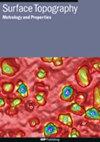激光加工表面形貌对氧化锆基牙科材料表面特性的影响:表面疏水性、抗菌行为和细胞反应
IF 2
3区 材料科学
Q2 ENGINEERING, MECHANICAL
引用次数: 0
摘要
近年来,对高性能植入物的持续需求导致了对生物陶瓷地形模式的广泛研究。其优异的美观性、生物相容性、低菌斑亲和力和重现自然外观的能力促成了其在牙科领域的成功。3mol %钇稳定氧化锆(3YSZ)由于其优异的机械性能和暴露在体温下最小的降解,作为一种牙科植入材料越来越受欢迎。然而,这些材料在牙科应用方面的生物和抗菌性能有限。本研究的目的是利用激光烧蚀技术在3YSZ陶瓷表面建立微形貌,以提高其生物反应和抗菌性能。利用激光烧蚀技术在氧化锆陶瓷表面制备了微沟槽和微通道两种微结构。研究了不同微结构对3YSZ陶瓷润湿性、生物性能和抗菌性能的影响。结果表明,所有的微观结构模式都能提高3YSZ的性能。润湿性是决定结构氧化锆陶瓷抗菌性能的决定性因素。微织构表面均表现出疏水性,从而有效地提高了3YSZ陶瓷的抗菌性能。在成骨前MC3T3-E1细胞的氧化锆纹理表面和非纹理对照组上评估细胞表面相互作用7天。实验结果表明,氧化锆表面结构对细胞生物学反应有积极的影响。本文章由计算机程序翻译,如有差异,请以英文原文为准。
Effects of surface topography through laser texturing on the surface characteristics of zirconia-based dental materials: surface hydrophobicity, antibacterial behavior, and cellular response
The continuous need for high-performance implants that provide significant biological properties has led to extensive research into the topographic patterns of bioceramics in recent years. Their excellent aesthetics, biocompatibility, low plaque affinity, and ability to reproduce a natural-looking appearance have contributed to their success in dentistry. 3 mol% Yttria-stabilized zirconia (3YSZ) is gaining popularity as a material for dental implants due to its excellent mechanical properties and minimal degradation when exposed to body temperature. However, such materials show limited biological and antibacterial performance for dental applications. The purpose of this work was to develop microtopographies on the surface of 3YSZ ceramic by laser ablation technique, in order to improve its biological response and antibacterial behaviors. Two types of microtextures, including micro-grooves and micro-channels geometries were fabricated onto the zirconia ceramics using the laser ablation technique. The effects of different microtextures on the wettability, biological and antibacterial behaviors of 3YSZ ceramics were studied. The results indicate that all of the microstructure patterns are capable of improving the performance of 3YSZ. Wettability is a decisive factor that determines the antibacterial performance of textured zirconia ceramics. The microtextured surfaces all display hydrophobic behavior, thus yielding an effective improvement of antibacterial performance for 3YSZ ceramics. Cell-surface interactions were assessed for 7 days on both zirconia textured surfaces and a nontextured control with pre-osteoblast MC3T3-E1 cells. The obtained results showed the positive influence of textured zirconia surfaces on cell biological response.
求助全文
通过发布文献求助,成功后即可免费获取论文全文。
去求助
来源期刊

Surface Topography: Metrology and Properties
Materials Science-Materials Chemistry
CiteScore
4.10
自引率
22.20%
发文量
183
期刊介绍:
An international forum for academics, industrialists and engineers to publish the latest research in surface topography measurement and characterisation, instrumentation development and the properties of surfaces.
 求助内容:
求助内容: 应助结果提醒方式:
应助结果提醒方式:


